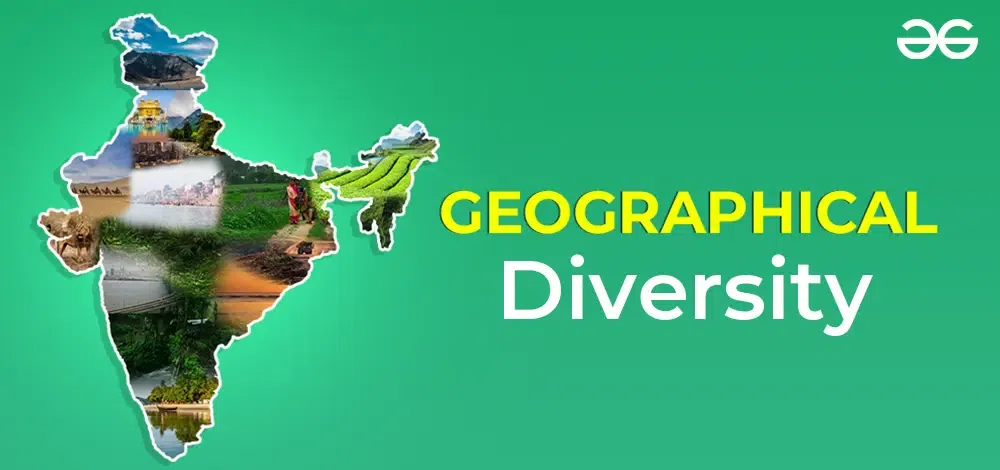What is Geographical Diversity?
Last Updated :
24 Jan, 2024
Geographical Diversity: India is a very diversified country and has various physical features. The geography of India is one of diversity, with ranges of landscapes that include mountains, plains, forests, plateaus, deserts, and also coastal plains. Various climatic conditions are experienced in India due to its various physical features. Some important diversities include:
- Deccan Plateau is situated in the Southern part of India.
- The southeast portion of India is bounded by the Bay of Bengal and the Southwest portion by the Arabian Sea.
- Fertile lands are covered in the Indo-Gangetic plains of northern, eastern, and central India.
- Location of Thar desert in the west.
- Monsoonal climatic conditions of India.

Geographical Diversity in India
Geographical Diversity
The term variety alludes to the distinction and assortment of individuals, creatures, or things that occupy or coincide in a given region. The word variety comes from the Latin different. Portray the variety or wealth of existing species or things. There is organic, etymological, sexual, social, topographical, orientation, and so on variety.
Nonetheless, that arrangement of normal or fake components that vary from each other by size, variety, surface, beginning, synthetic structure and uses, and make up an area or locale, share one element for all intents and purposes.
At the point when this large number of components coincide inside a similar geographic space, moderately little or delimited and separated from others, then, at that point, this variety of variables or components is called: topographical variety.
.webp)
Geographical Diversity of India
Geologically, India can be isolated into four locales. The first is the Himalayan area or the Northern Mountain wall that stretches out from Kashmir in the West to Assam in the East. This district incorporates Kashmir, Kangra, Tehri, Kumaon Nepal, Sikkim, and Bhutan. The subsequent district is the incredible and enormous Northern Plains which are furnished with water by the streams like Indus, Ganges, Brahmaputra, and their feeders.
Because of this, the locale is generally fruitful and useful. The third area contained the level of the Central India and the Deccan. The Western Ghats and the Eastern Ghats are extended on the different sides of the Deccan which meets at the Nilgiris. The Coromandel Coast remains between the Eastern Ghats and the Bay of Bengal.
The locale between the Arabian Sea and the Western Ghats is known as the Konkan up to Goa past which is known as Kanara or Karnataka while the Southern part is known as the Malabar Coast or Kerala. The antiquated name of Western Ghats was Sahyadri while that of Eastern Ghats was Mahindra. Unified India is just about as extensive as Europe without Russia. India contains around one-fifth of the complete populace of the entire world. Hence the actual elements of the country with its various streams and grandiose mountains favor a speculative twisted psyche among individuals living in these geological locales. This geological component advanced the development of a composite culture of the country.
India and Diversity
India may not be blended without anyone else but rather from times old India has been considered as-one country. The main name Bharatvarsha has conceded to this country’s accentuation of this solidarity. As per the creators of ‘Advance History of India’, the word and the idea of solidarity actually imply, “have consistently existed in the personalities of scholars, political thinkers, and writers who discussed a huge number of yojanas (classes) of the land that stretches from the Himalayas to the ocean as the standard field of a solitary general sovereign.”
Over the course of bygone eras, Muslim rulers too thought of it as one nation and bent over backward to hold onto it. Nature has likewise preferred territorial solidarity by giving the Himalayas North and the ocean to the next three sides of the nation, and consequently totally isolating India from different nations.
The streams of India are likewise liable for giving a feeling of solidarity to the country. A portion of the waterways are of a heavenly beginning and are viewed as hallowed by all Indians. For instance, Ganga is adored by all the local area experts. Pioneers from everywhere in the nation keep on visiting the sanctuaries remaining on their banks. Different streams, like the Yamuna and Saraswati waterways, are additionally viewed as hallowed by individuals all through the country. So, we can express that notwithstanding the topographical variety, the nation has partaken in a good judgment of solidarity.
FAQs on Geographical Diversity
What is meant by geographical diversity?
Geographical diversity is the degree to which certain physical separation occurs between the generation of resources and to the utility of resources which is affected by various factors like climatic conditions, disruptions, etc.
What is geographical diversity in India?
Geographical diversity in India includes plateaus, forests, hills, mountains with snow, deserts as well as plains.
How is the geographical diversity of India important?
Geographical diversity includes the fertile plains of India which are productive, whereas there are unproductive areas as well which are supported by the productive areas and transportation.
Share your thoughts in the comments
Please Login to comment...